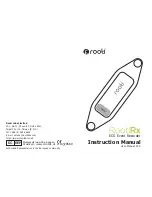
38
39
• RMSSD / Heart Rate.
This tab gives most informa-
tion to the athlete. After heavy exercise the evening
RMSSD should be clearly down from the baseline
(this can be used as indication of exercise load), and
towards the morning there should be rising and fluc-
tuating trend. This tells about the recovery rate dur-
ing the night. If curve trends downwards, one may be
getting ill, having digestive problems, sleeping bad,
or stressing about work, relationship, or something
else. Ideally RMSSD curve should be either horizontal
(if there is no stress / exercise to recover from), or it
should form rising trend towards morning (indicating
healthy recovery).
NOTE!
All screens have history of seven last days
graphically displayed, which makes it easy to see where
one goes each day in relation to other days.
RMSSD GRAPH
(ESPECIALLY USEFUL FOR ATH-
LETES)
At dashboard, seven days mini graphs should give in-
stantly indication how this particular day is in relation
to earlier days, and whole night RMSSD graph gives
useful information about daily loads and recovery
during the nigh time. Here is short information about
how to interpret whole night RMSSD graph:
In this graph we display total recovery in terms of
RMSSD value, and also speed of recovery as RMSSD
units / hour.
This should give several kinds of information:
1) If Evening RMSSD value is low (enough), it is indica-
tion that exercise has been (sufficiently) heavy.
1) If Morning RMSSD value is high (enough), it is in-
dication that recovery throughout the night has pro-
gressed as expected, and you are ready for another
heavy exercise.
2) If graph has upward trend, and Recovery Ratio is
clearly > 1 there has been recovery during night.
3) If graph is mostly horizontal and Recovery Ratio is
around 1, there probably has been no load nor recov-
ery.
4) If graph has downward trend and Recovery Ratio
is clearly < 1, it might be indication of uncontrollable
stress, or about some physical condition (some sick-
ness creeping in, digestive problems, overreaching,
etc.)
This information might help you to adjust your train-
ing load. Also resting HR value is useful, if it suddenly
bumps up, there might be something wrong in your
body.
RMSSD graph should consist of equally spaced dots
(one at every 3 mins, 20 dots / hour). If there are miss-
ing dots, it is indication of bad signal. In this case you
should check the location of sensor, so that it is direct-
ly under your chest while you sleep.
• QS can’t find my wireless network during setup
QS searches for open network when powered up in AP
mode (after factory reset or taken first time out from the
sales Box). Make sure that wireless network is available
and it is not hidden. For connecting to hidden networks
please see chapter 8.2.4.
• QS fails to connect to my wireless network (fail
sound after connecting attempt)
QS supports only Wi-Fi 802.11 b/g/n (2,4 Ghz only). Wi-Fi
channels 11-13 are not supported. Make sure your router is
not set to these channels and that speed is 2,4 Ghz. Refer
to your router’s user manual for help.
Make sure you have typed the Wi-Fi password correctly.
If you can’t get it connected after another attempt please
contact customer support.
• Red light keeps blinking even though I have connect-
ed QS to my wireless network successfully (success
sound after connecting attempt)
Red light should stop flashing completely within 2 min-
utes after successfully hooking QS up to your Wi-Fi. This
means that QS is communicating with Emfit cloud server.
There is nothing that the user can do to speed up this pro-
cess. Occasionally red light may flash when the device is
being used. There may be a temporary error that prevents
the device from communicating with the cloud service.
You can leave it be even though the red light is flashing.
If red light does not stop flashing within 24 hours please
contact customer service.
• Red light is constantly on
There may be something wrong with your sensor. Please
contact customer support.
• My sleep period is too long
Too long sleep periods are usually caused by the device
not registering that you have left the bed. If you need to re-
move power supply after wake up please wait until green
turns from continuous on state to blinking. This happens
usually within 10 seconds after getting up and means that
the device has registered bed exit. Too long sleep periods
can also be edited manually at the user interface.
• My sleep period is not registered or data is missing
Usually sleep periods will be available within one hour af-
ter getting up from bed. Connection cutoffs (either with
your wireless network or at Emfit server) may however
prolong this time. If you continue having this issue please
contact customer support.
• My sleep data is inaccurate
Device may every now and then make false assumptions
about your sleep. For example device may interpret that
you were asleep while in reality you were awake but com-
pletely still. We are constantly working to improve our
sleep algorithms to make sleep detection as precise as
possible.
Your QS will always be automatically updated to the new-
est possible firmware with newest improvements.
• Green light stays on even if I have left the bed or green
light keeps blinking when I’m on bed
If you have just recently taken the device into use please
wait for a couple of days. During the first days sensitivi-
ty adjustments are being made and most likely problem
settles on its own over time. If you continue having this
problem after a few days of use please contact customer
support.
13. Troubleshooting
Содержание QS
Страница 24: ...Notes ...






































